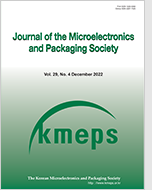
Search
- Past Issues
- e-Submission
-

KCI Accredited Journals KCI 등재지
KCI Impact Factor 0.54
Editorial Office
- +82-2-538-0962
- +82-2-538-0963
- kmeps@kmeps.or.kr
- http://kmeps.or.kr/

KCI Accredited Journals KCI 등재지
KCI Impact Factor 0.54
Journal of the Microelectronics and Packaging Society 2024;31(3):91-98. Published online: Oct, 30, 2024
DOI : doi.org/10.6117/kmeps.2024.31.3.091
This study reveals the feasibility and effectiveness of sinter bonding using an Ag nano-porous sheet at the lowest “theoretically” possible temperature of 145 °C. By uniform pressure of 10 MPa for bonding times of 5 min and 10 min at 145 and 175 °C, we achieved bonding strengths exceeding approximately 20 MPa with a only 5 min of bonding time at 145 °C. In particular, it is interesting to note that in the pressure sintering bonding process at 145 °C, bonding times of 5 and 10 min had no significant difference in strength. Even with a bonding temperature of 175 °C, the difference in average bonding strength between bonding times of 5 min (i.e., 37.6 MPa) and 10 min (i.e., 43.0 MPa) was only 5 MPa. The bonding strength was fundamentally attributed to the thickness of the Ag sintered neck in the Ag sintered layer. Microstructural analysis revealed that as the bonding temperature increased to 175 °C, the fraction of CSL Σ3 boundaries within the Ag sintered layer increased, indicating greater coalescence of Ag particles. This study systematically investigated the mechanism of bonding strength in extremely low-temperature pressure Ag sinter bonding, considering the relationship between microstructures and mechanical behaviors.
Keywords Ag nano-porous sheet, Sheet bonding, Power module, Pressure bonding process, Mechanical strength